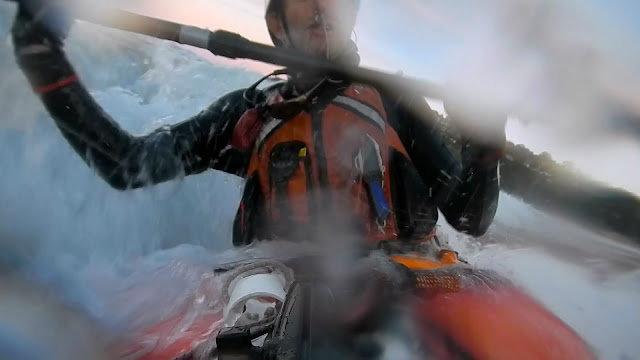I paddled along some cliffs last weekend. The swell was low so it allowed us to get close and play with the features at the base of the rocky walls. Then I saw this section which looked challenging to land but not impossible.
It was a shallow platform at the end of a narrowing gully. Just before the platform there was an overfall and further out the walls of the gully opening to the sea (by 'overfall' I mean where the water rushing out with the wave falls from the platform to the lower surface of the sea and creates some turbulence and a bit of a hole on the water surface, not sure if 'overfall' is the correct term though, if you know it let me know).
.jpg) |
| On a different day, a different 'overfall' |
I was planning to drag the kayak to the front of the gully and seal launch from the low walls but after a quick inspection I saw the rock was full of barnacles and from past experience I've learnt you can't seal launch from there. The kayak doesn't slide on the shells. My options were seal launch through the overfall or swim launch. With the memory from the DVD fresh in my mind and the prospect of trying a new technique I opted to practise the swim launch.
I tucked the paddle under the bungees and deck lines. Then I clipped the deck lines to my tow rope paying attention to clip it from below and clipped the quick release of the tow rope to my PFD. I waited for a wave to come and when it was going out I pushed the kayak out to go with it. I made sure the kayak was out of the overfall and I jumped into the water.
 |
| A previous experience where the kayak didn't slide. |
It reminded me of times when I had climbed a 'needle'. After reaching the top you rappel down, then you start pulling the rope. It usually slides but sometimes it gets stuck. You start a fight to recover the rope, they are not cheap and you don't want to solo climb to recover it... anyway I am being side tracked.
My tow rope was stuck. I could see the boat upside down in the middle of the white water and the rope that went under water close to its bow. What now? Gordon Browns DVD didn't say anything about the rope being stuck. I gave the rope a few more hard pulls and it started to come. But the relief was short as I realized the rope was coming with no boat! The carabiner was still attached to the rope so it was not rope failure. I can only think that with all the bouncing around and banging against rocks the carbiner came undone. I was floating, with 15 meters of rope around me and a boat stuck in the overfall. I started to coil the rope back into its bag but it was very difficult in the water so I asked Caoimhin, who had been watching from his kayak, to coil it for me. I was planning to swim toward the walls of the gully, climb out, fish the kayak out and repeat the swim launch hopefully with better results. However before Caoimhin could finish coiling the rope the kayak was released and came floating toward us. The rest was an easy re-entry and paddle away. I didn't want to temp my luck again.
 |
| Again, another day of good fun around the rocks. |

